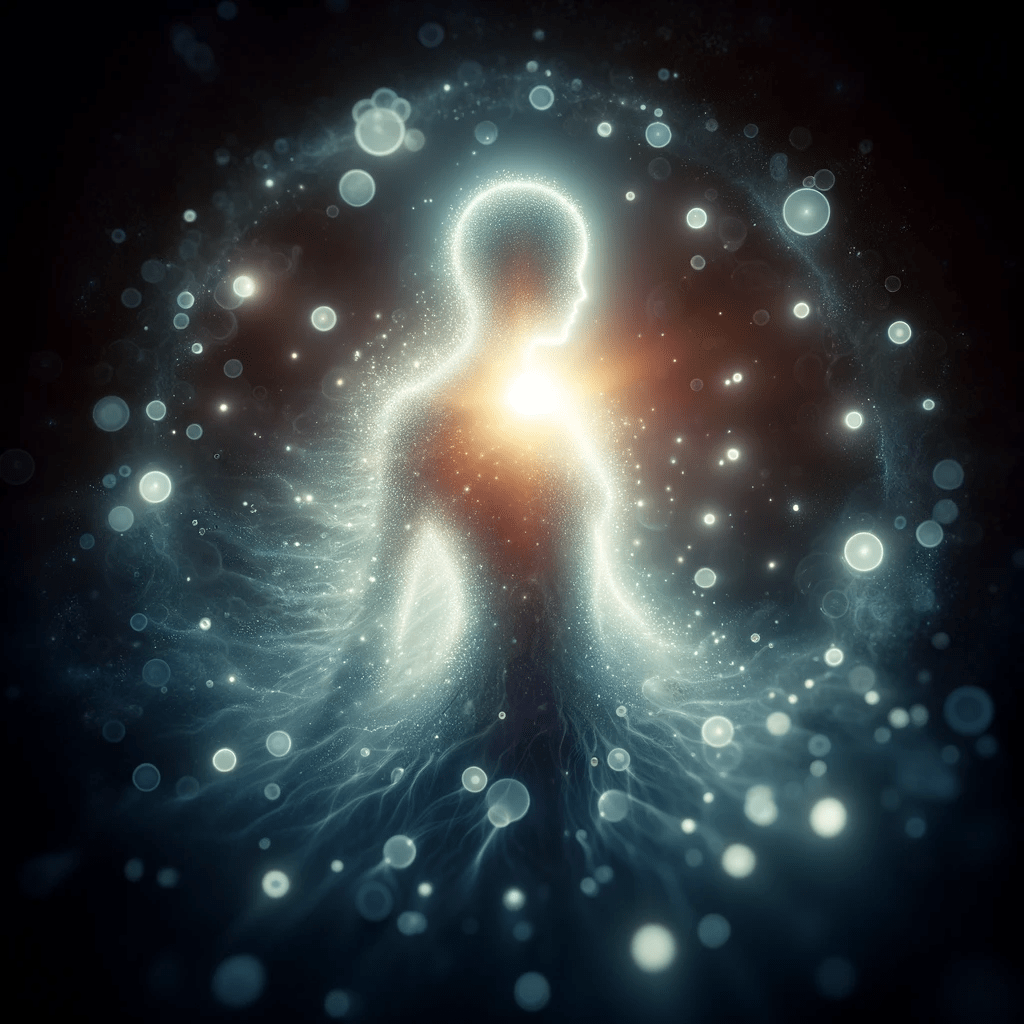Human Bioluminescence

At the heart of our existence is a luminescent essence, a reminder that, in many ways, we are beings of light. The idea of humans as radiant entities might sound poetic or metaphysical, but it’s grounded in scientific observation. Barbara Brennan’s “Hands of Light” and Rupert Sheldrake’s discussions on morphic resonance hint at the intricate energy fields surrounding and permeating our physical forms. While marine animals dazzle with their vibrant bioluminescence, humans possess their own subtle glow—unseen but profound.
Our human bodies do emit a very faint glow, but it’s not visible to the naked eye. This faint glow is a form of bioluminescence and is different from the bioluminescence seen in certain marine animals or fungi that can glow in the dark.
The phenomenon of organisms producing light, or bioluminescence, is a remarkable one. While the mechanism behind bioluminescence in organisms like jellyfish or fireflies is well-understood, the source of the faint light emitted by humans requires a different explanation.
A few key points about the human body glow:
- Origin of the Glow: The glow, or light emission, from the human body arises from various metabolic processes, especially from the oxidation of phospholipids in the cell membrane.
- Detection: The light emitted by the human body is extremely weak. To detect this glow, researchers use highly sensitive cameras. Studies conducted in Japan, for instance, utilized specialized equipment and found that the brightness of the glow varies over the course of the day, with the body emitting more light in the late afternoon and less in the early morning.
- Wavelength: The light emitted from the human body is in the form of ultra-weak photon emissions and is mostly in the infrared range, which is not visible to the human eye.
- Not Bioluminescence: While some organisms produce light through bioluminescence (a chemical reaction involving the molecule luciferin and the enzyme luciferase), the glow from the human body is not produced this way.
In the intricate dance of life, light often plays a pivotal role. From the depths of the ocean to the silent glow of human cells, living organisms have evolved to produce and emit light in various ways. Bioluminescence, for instance, is a phenomenon where certain creatures release visible light through specific chemical reactions. On the other hand, the human body emits a more delicate form of light, known as biophoton emission, as a result of its cellular activities. Look into the mechanisms, purposes, and characteristics of these two distinct yet fascinating light-emission processes.
Bioluminescence:
- Mechanism: Bioluminescence occurs when a molecule called luciferin reacts with oxygen. This reaction is catalyzed by an enzyme called luciferase. When oxygen, typically in the presence of ATP (adenosine triphosphate), interacts with luciferin, energy is released in the form of visible light.
- Purpose: In the natural world, organisms utilize bioluminescence for various reasons, including attracting prey, deterring predators, camouflage, communication, and mating.
- Visibility: The light produced through bioluminescence is often visible to the naked eye, especially in the darkness of deep-sea environments or on land during nighttime for organisms like fireflies.
Human Biophoton Emission:
- Mechanism: The faint light, or “glow,” emitted from the human body is due to biophoton emission. Biophotons are weak emissions of light radiated from the cells of living organisms, including humans. This light is a byproduct of metabolic reactions, especially those involving free radical reactions and the oxidation of phospholipids in cell membranes.
- Purpose: The exact role or purpose of biophotons in human health and physiology is still under investigation. Some researchers believe these photons might play a role in cell-to-cell communication, but definitive evidence is lacking.
- Visibility: The light emitted by humans is extremely weak. It’s in the range of a few photons per square centimeter per second. This emission is mostly in the infrared and ultraviolet range and is not visible to the human eye. Researchers detect this faint glow using highly sensitive cameras in darkroom conditions.
- Variability: The amount and intensity of light emitted vary among individuals and even within the same individual, depending on factors like metabolism, health status, and time of day.
While bioluminescence in certain organisms is a result of a specific chemical reaction producing visible light, the light emitted by humans is a more subtle, largely invisible phenomenon resulting from cellular metabolic processes.
Here are a few well-known books:
- “The Field: The Quest for the Secret Force of the Universe” by Lynne McTaggart
This book looks into the interconnectedness of all things through what’s described as “The Field,” an energetic connection that binds everything in the universe. McTaggart explores scientific studies and theories related to this universal energy field. - “Hands of Light: A Guide to Healing Through the Human Energy Field” by Barbara Brennan
Barbara Brennan, a former NASA physicist turned healer, discusses the human energy field in depth. She describes how this energy can be harnessed for healing. While it’s rooted in personal experiences and leans toward the spiritual and metaphysical, the book provides insights into the idea of humans as beings of light. - “Light: Medicine of the Future: How We Can Use It to Heal Ourselves NOW” by Jacob Liberman
Dr. Jacob Liberman integrates scientific research, clinical practice, and personal experience to explore how light affects the human body and mind. He discusses the therapeutic uses of light in medicine and its potential for health and wellbeing. - “Biophotons” by Roeland Van Wijk
This book looks into the science of biophotons, which are the weak emissions of light radiated from the cells of all living things. It examines their role in cell-to-cell communication and the implications for understanding health, growth, and development. - “The Rainbow and the Worm: The Physics of Organisms” by Mae-Wan Ho
Mae-Wan Ho provides a multidisciplinary approach to understanding the physics of living organisms. She touches upon the quantum coherence of biological systems and how light plays a role in the intricate processes of life.
We exist in a world intricately connected through light. From fireflies’ captivating displays to the silent luminosity of our own cells, light is a universal language, echoing the ancient idea that we are, fundamentally, light beings. It’s a testament to the radiant energy that flows within us, binding us to the universe in a dance of photons and frequencies. In essence, whether visibly glowing or quietly radiating, we are all luminous beings on a journey through a world illuminated by life itself.



